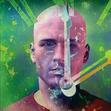Marty Halpern's Blog, page 32
May 14, 2013
Kage Baker's In the Company of Thieves
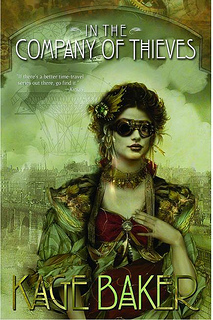 In May 2001, I contacted Kage Baker via email about a collection of Company stories; at the time I was acquiring and editing for Golden Gryphon Press. Kage responded the very same day, stating that she was intrigued with my proposal and that she has forwarded my letter to her agent, Linn Prentis. On May 9 I received a response from Linn: the collection was a "go."
In May 2001, I contacted Kage Baker via email about a collection of Company stories; at the time I was acquiring and editing for Golden Gryphon Press. Kage responded the very same day, stating that she was intrigued with my proposal and that she has forwarded my letter to her agent, Linn Prentis. On May 9 I received a response from Linn: the collection was a "go."Black Projects, White Knights: The Company Dossiers
 premiered at the San Jose WorldCon on August 29, 2002. The book was even more successful than I had anticipated: Publishers Weekly gave the collection a starred review; the first printing of 3,000 copies sold out in only two months; there was a second hardcover printing, and the trade paperback edition was published in October 2004. In a blog post dated January 27, 2010 -- just four days before Kage Baker passed away -- I detailed how Kage and I worked together on this book, how it all came together.
premiered at the San Jose WorldCon on August 29, 2002. The book was even more successful than I had anticipated: Publishers Weekly gave the collection a starred review; the first printing of 3,000 copies sold out in only two months; there was a second hardcover printing, and the trade paperback edition was published in October 2004. In a blog post dated January 27, 2010 -- just four days before Kage Baker passed away -- I detailed how Kage and I worked together on this book, how it all came together.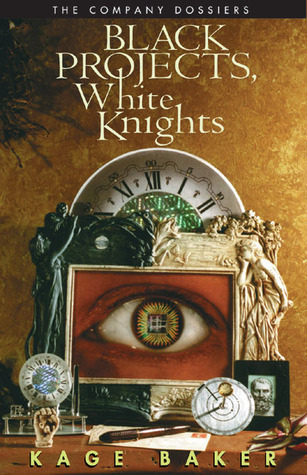 And now, nearly to the day and twelve years later, I have the good fortune to be able to work on what will, unfortunately, be the last new collection of Company stories by Kage Baker:
In the Company of Thieves
And now, nearly to the day and twelve years later, I have the good fortune to be able to work on what will, unfortunately, be the last new collection of Company stories by Kage Baker:
In the Company of Thieves
 , forthcoming from Tachyon Publications.
, forthcoming from Tachyon Publications.Working on these stories is like meeting up with old friends again, like the immortal cyborg Joseph (in "Hollywood Ikons," a new story original to the collection; more on this in a bit), Edward Bell Fairfax and Lady Beatrice, of the Gentlemen's Speculative Society and Ladies Auxiliary, respectively (in "The Women of Nell Gwynne's" and "The Unfortunate Gytt"), and the evil Labienus and his Plague Cabal (in "Mother Aegypt"). Note that I didn't say they were all "good" friends....
So many memories have come flooding back since I began work on this collection of stories: working on Black Projects, White Knights and then the limited edition chapbook story The Angel in the Darkness; meeting up with Kage at cons -- she was always with her sister Kathleen and I was usually with my wife Diane -- which typically entailed a long chat over lunch or dinner. Did you know Kage's favorite drink is (was) a mojito? Meeting niece "Emma Rose" (read the novel The Hotel Under the Sand
 , also from Tachyon Pubs) at Kage's appearance at SF in SF on July 25, 2009. And... I could go on, but you get the drift. We were friends, and I always looked forward to the next meeting/lunch/dinner at the next con.... And now we (Diane and I) get to continue that friendship with Kathleen, hopefully sharing a meal at BayCon over the Memorial Day weekend.
, also from Tachyon Pubs) at Kage's appearance at SF in SF on July 25, 2009. And... I could go on, but you get the drift. We were friends, and I always looked forward to the next meeting/lunch/dinner at the next con.... And now we (Diane and I) get to continue that friendship with Kathleen, hopefully sharing a meal at BayCon over the Memorial Day weekend.Only six stories make up In the Company of Thieves, but those six stories entail more than 100,000 words of very fine fiction. Three of the stories are novella length, at 25,000-plus words. Two additional stories clock in at around the 12,000-word mark. And one story ("The Carpet Beds of Sutro Park"), one of my very favorites, is a mere 3,700 words. I am constantly amazed at what Kage can accomplish in so few words.
Previously I mentioned a new story, "Hollywood Ikons" (one of the 12,000-word stories mentioned above), to be published in this collection for the first time. The story is a collaboration, as it were, between Kage and her sister Kathleen Bartholomew. From the draft copy of Kathleen's story notes:
Before Kage died in 2010, this was one of the stories she told me to look at first....Kage had already assigned Joseph as the hero of this one, so all I had to do was channel her and connect the gold-limned dots."So I can only hope that Kage has left behind piles of notes and outlines and that Kathleen is able to continue channeling Kage into new stories of the Company, of Dr. Zeus Incorporated, of the Gentlemen's Speculative Society... Or, better yet, I can hope that Kathleen eventually graces us with her own unique tales of wonder.

Published on May 14, 2013 10:32
May 6, 2013
Doin' Hard Time at Night Shade Books
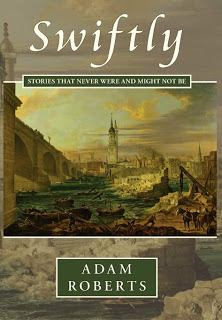
How often, how many times, have you asked yourself, What have I done with my time? What have I really accomplished?
I've been asking myself this very question quite a bit of late; or, at least, more than I normally do....
I spent about nine years of my professional career working for Night Shade Books. If you are a genre writer and/or reader, then you probably have seen an online article, or blog post, about the publisher's demise. Essentially Night Shade Books is bankrupt, they just haven't declared it legally (yet), but are hoping to sell the assets of the company to a pair of publishing houses. I won't go into any of that here; you can just search for "Night Shade Books" and you'll find enough to read: posts from authors talking about the deal with the new buyers, posts from bloggers both objective and subjective about Night Shade, and so on.
But what I see is the demise of a publishing house that had the potential to make it into the "big leagues" as an independent. I recall an early telephone conversation with publisher/owner Jason Williams, in which he told me that he wanted Night Shade to be the next Baen Books. And they could have been, I honestly believe that, but they squandered it all away....
But six months from now, a year from now, will new readers even know who Night Shade Books is? And for those of us who know of them now, what will we think of them going forward? Will readers think of the books with positive memories: the great books like <i>The Algebraist</i> and <i>The Windup Girl</i>; the beautifully designed covers and interiors? Or will they remember the orders not fulfilled, the books promised and never published? Will former Night Shade authors remember Night Shade as the publisher who gave them their first break, bought and published their first book, bought and published the book that they were unable to sell to any New York publisher? Or will they remember that they were never paid their advance, never paid royalties, or if they did get paid, that they had to fight for every dollar, or that their book never even got published as promised?
But getting back to my original question: Just what have I accomplished in nearly nine years with this publisher? And what will I remember?
I sat down and reviewed all my invoices -- 190 of them -- dating back to 2004, and compiled a list of all the books I touched, so to speak. The first book was Adam Roberts's short fiction collection, Swiftly; the last book was Jonathan Strahan's anthology, The Best Science Fiction and Fantasy of the Year, Volume Seven, just this past January. And in between were a helluva lot of books.
Adam Roberts – Swiftly short story collection (May)
M. John Harrison – The Course of the Heart novel (June)
Iain M. Banks – The State of the Art short story collection (August)
Manley Wade Wellman – Giants from Eternity novel (September)
Manley Wade Wellman – Strangers on the Heights novel (September)
S. T. Joshi and David E. Schultz, editors – H. P. Lovecraft's Letters from New York (December)
2005
Joe R. Lansdale – Dead in the West novel (February)
Joe R. Lansdale – The Boar novel (February)
Steven Erikson – Blood Follows novella (March)
Terry Lamsley – Conference with the Dead short story collection (March)
Matthew Hughes – The Gist Hunter and Other Stories (May)
Steven Erikson – The Healthy Dead novella (July)
Gwyneth Jones – Bold As Love novel (July)
Joe Haldeman – War Stories (August)
Liz Williams – Snake Agent novel (August)
David Drake – Hammer’s Slammers, Volume 1 (October)
Douglas Lain – Last Week’s Apocalypse short story collection (November)
Joel Lane – The Lost District short story collection (November)
2006
Neal Asher – Prador Moon novel (January)
Ray Manzarek – Snake Moon novel (January)
Tricia Sullivan – Maul novel (January)
Liz Williams – The Demon and the City novel (February)
Elizabeth Bear – The Chains That You Refuse short story collection (March)
Andrew Migliore and John Strysik – The Lurker in the Lobby: The Guide to Lovecraftian Cinema (March)
Kage Baker – Dark Mondays short story collection (April)
Glen Cook – A Cruel Wind Dread Empire omnibus (May)
Alexander C. Irvine – Pictures from an Expedition short story collection (June)
Jay Lake – Trial of Flowers novel (July)
Alastair Reynolds – Zima Blue and Other Stories (July)
Glen Cook – Sung in Blood novel (September)
David Drake – Hammer’s Slammers, Volume 2 (September)
Matthew Hughes – Majestrum novel (September)
Walter Jon Williams – Hardwired novel (September)
Jon Armstrong – Grey novel (October)
Tim Pratt - Hart & Boot & Other Stories short story collection (October)
George Saunders - Imaro 2: The Quest for Cush novel (November)
2007
Jonathan Strahan, editor – The Best Science Fiction and Fantasy of the Year, Volume One (January)
Glen Cook – Passage at Arms novel (January)
Glen Cook – A Fortress in Shadow Dread Empire omnibus (February)
David Drake – Balefires short story collection (February)
Lucius Shepard – Softspoken novel (February)
Jon Courtenay Grimwood – 9 Tail Fox novel (March)
Laird Barron – The Imago Sequence and Other Stories short story collection (April)
Richard Kadrey – Butcher Bird novel (April)
Nathalie Mallet – The Princes of the Golden Cage novel (April)
Liz Williams – Precious Dragon novel (April)
Walter Jon Williams – The Voice of the Whirlwind novel (April)
Matthew Hughes – The Spiral Labyrinth novel (May)
Alex Bledsoe – The Blonde-edged Sword novel (June)
S. M. Stirling – Ice, Iron and Gold short story collection (June)
Elizabeth Moon – Moon Flights short story collection (July)
Jonathan Strahan, editor – Eclipse One (August)
John Joseph Adams, editor – Wastelands (September)
David Drake – Hammer’s Slammers, Volume 3 omnibus (September)
Paolo Bacigalupi – Pump Six and Other Stories (October)
Glen Cook – The Dragon Never Sleeps novel (October)
Jonathan Strahan, editor – The Best Science Fiction and Fantasy of the Year, Volume Two (December)
2008
Walter Jon Williams – Implied Spaces novel (January)
Greg Egan – Incandescence novel (January)
Neal Asher – Shadow of the Scorpion (May)
Harry Turtledove – After the Downfall novel (May)
Liz Williams – Shadow Pavilion novel (May)
Mark Teppo – Lightbreaker: Book One of the Codex of Souls novel (June)
Nathalie Mallet – The King’s Daughters novel (June)
John Joseph Adams, editor – The Living Dead (July)
Matthew Hughes – Hespira novel (July)
Seamus Cooper – The Mall of Cthulhu novel (August)
Tim Lebbon – Bar None novel (August)
Ann VanderMeer and Jeff VanderMeer, editors – Fast Ships, Black Sails (August)
Stephen Baxter – The H-Bomb Girl novel [note: never published] (September)
Glen Cook – An Empire Unacquainted with Defeat Dread Empire omnibus (September)
Jonathan Strahan, editor – Eclipse Two (September)
Graham Joyce – How To Make Friends with Demons novel (October)
Steven Erikson – The Lees at Laughter’s End novella (November)
Jay Lake – Madness of Flowers novel (November)
Jonathan Strahan, editor – The Best Science Fiction and Fantasy of the Year, Volume Three (December)
2009
John Langan – House of Windows novel (January)
Glen Cook – The Swordbearer novel (February)
Paolo Bacigalupi – The Windup Girl novel (April)
John Joseph Adams, editor – By Blood We Live (May)
John Joseph Adams, editor – The Improbable Adventures of Sherlock Holmes (June)
Glen Cook – Darkwar Trilogy omnibus (July)
Ellen Datlow, editor – The Best Horror of the Year, Volume 1 (August)
Jonathan Strahan, editor – Eclipse Three (September)
Mark Teppo – Heartland: Book Two of the Codex of Souls novel (October)
Liz Williams – The Iron Khan novel [note: never published] (November)
2010
Laird Barron – Occultation and Other Stories (January)
Greg Egan – Zendegi novel (January)
Walter Jon Williams – The Green Leopard Plague and Other Stories (January)
Fritz Leiber: Selected Stories (February)
The Best of Kim Stanley Robinson (March)
John Joseph Adams, editor – The Living Dead 2 (April)
Jon Armstrong – Yarn novel (May)
Michael A. Stackpole – At the Queen’s Command: The Crown Colonies, Book One novel (July)
Catherynne M. Valente – The Habitation of the Blessed: A Dirge for Prester John, Volume One novel (August)
Phil Foglio and Kaja Foglio – Agatha H. and the Airship City novel (September)
Kameron Hurley – God’s War novel (October)
Will McIntosh – Soft Apocalypse novel (October)
Martha Wells – The Cloud Roads novel (October)
Jonathan Strahan, editor – The Best Science Fiction and Fantasy of the Year, Volume Five (December)
2011
Jonathan Strahan, editor – Eclipse Four (January)
Michael Swanwick – Dancing with Bears novel (January)
Ellen Datlow, editor – The Best Horror of the Year, Volume 3 (February)
Marty Halpern, editor – Alien Contact (May)
Glen Cook – Reap the East Wind novel (May)
Kameron Hurley – Infidel novel (May)
Richard Cox – Thomas World novel (June)
Glen Cook – An Ill Fate Marshalling novel (July)
Rob Ziegler – Seed novel (July)
Glen Cook – A Path to Coldness of Heart novel (August)
M. Valente – The Folded World: A Dirge for Prester John, Volume Two novel (August)
Michael A. Stackpole – Of Limited Loyalty: The Crown Colonies, Book One novel (September)
Will McIntosh – Hitchers novel (October)
David Williams – Pillars of Hercules (November)
2012
Jonathan Strahan, editor – The Best Science Fiction and Fantasy of the Year, Volume Six (January)
John Joseph Adams, editor – Other Worlds Than These (May)
Joseph Adams, editor – Brave New Worlds, 2nd Edition (August)
Kameron Hurley – Rapture novel (August)
Mazarkis Williams – Knife Sworn novel (August)
Zachery Jernigan – No Return novel (October)
Mark Teppo – Earth Thirst novel (October)
Neal Asher – The Departure: The Owner, Book 1 novel (November)
Laird Barron – The Beautiful Thing That Awaits Us All novel (December)
M. John Harrison – Empty Space novel (December)
2013
Jonathan Strahan, editor – The Best Science Fiction and Fantasy of the Year, Volume Seven (January)
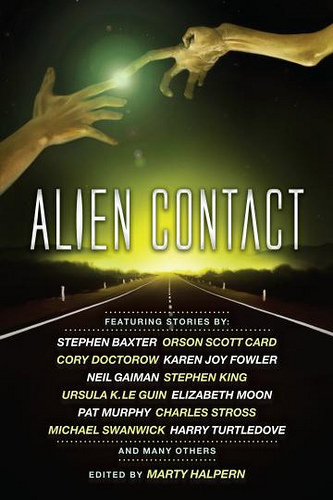
125 books. Count 'em! Some of these dates are relative, of course. For example, my work on Liz Williams's Detective Inspector Chen novel, The Demon and the City, covered a span of about four months, from February through May 2006, during which time I worked with the author on a full edit of the manuscript, copy edited the layout pages, and then proofed the ready-for-print layout along with the book's dust jacket. And then there was my own anthology, Alien Contact
 , in which I spent more than two years reading, compiling, and then acquiring stories, copy editing and proofing the layout pages, etc. -- not to mention blogging about each of the stories, one story per week for 26 weeks.
, in which I spent more than two years reading, compiling, and then acquiring stories, copy editing and proofing the layout pages, etc. -- not to mention blogging about each of the stories, one story per week for 26 weeks.Also, what you don't see on this list is an additional 66 books through the years in which I copy edited only the book's cover, and/or front matter, and/or back matter -- the earliest instances of this being the dust jackets for Iain M. Banks's The Algebraist and Lucius Shepard's Trujillo in July 2005, to July 2012, when I worked on four book covers: Ellen Datlow's The Best Horror of the Year, Volume 5, Michael J. Martinez's The Daedalus Incident, Peter Rawlik's Reanimators, and Carol Wolf's Binding. There were also press releases, catalog copy, ARC book covers, ebook covers, and reprint editions, none of which are listed here.
So, this is what I will remember... I never read a Hammer's Slammers story or a Dread Empire story until I had the opportunity to copy edit the works of David Drake and Glen Cook, respectively, for Night Shade Books. That I had an opportunity to read some phenomenal stories by such authors as Laird Barron, Alex Irvine, Elizabeth Moon, Alastair Reynolds, and Adam Roberts -- and that's not to mention the hundreds of individual stories in anthologies compiled by John Joseph Adams and Jonathan Strahan. And novels: whew! Paolo Bacigalupi's The Windup Girl, Kameron Hurley's Bel Dame Apocrypha trilogy, the first two Prester John novels by Catherynne M. Valente, books one and two of Mark Teppo's Codex of Souls, and, dare I not forget, Liz Williams's Detective Inspector Chen novels.
I'll remember how Night Shade Books was there when I decided to go freelance full time, and how they kept me working when the economy tanked in 2008.
But I'll also remember how month after month after month, for the past handful of years, I felt like I practically had to beg to get paid even a portion of the money that was owed to me at the time. In a blog post on April 5, 2013, author Kameron Hurley wrote:
For two years, I have equated writing fiction with grinning and bearing it. Getting promised the moon and then fucked over. Waiting for breach of contract. Waiting for expected payments. Being made promises full of sand that trickled just as quickly through clenched fists.
Simply replace her word "writing" with "editing" and you get the gist of how I've felt over the past two or so years working for Night Shade Books. When I read Kameron's post, and I came to that paragraph, I actually had tears in my eyes, because my love of editing had become a chore, had become painful: as I worked on each Night Shade project I worried about getting paid, knowing that I would have to email them again and again to ask for payment -- and should I talk with Jason on the telephone, I'll have to listen of all his tales of woe. I kept telling myself I needed to stop working for them, that this was just becoming too distasteful, but then a check would arrive, typically money owed from three-plus months back, but money nonetheless. I started to back off from the amount of work I accepted, hoping that Night Shade would catch up on money owed, but unfortunately that never happened. And here we are....
I'll keep my remaining vitriolic criticism to myself as that isn't going to change anything, but only make a bad situation worse. However, I am waiting to hear from someone, anyone, about the money that is owed to me for open invoices dating back through October of last year.
And not once that I recall, from May 2004 through January 2013, did I ever miss a promised delivery date on any of those 125 books. Never.

Published on May 06, 2013 16:39
April 22, 2013
Bradley P. Beaulieu's Lest Our Passage Be Forgotten
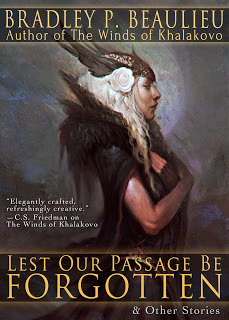
Artwork by Sang Han
Fate (if you believe in that sort of thing) has a way of, occasionally, flipping reality onto its head.
I have worked for Night Shade Books for these past nine years: the very first book I worked on was Adam Roberts's Swiftly, which I completed in May 2005; the last book I worked on, The Best Science Fiction and Fantasy of the Year, Volume Seven
 , edited by Jonathan Strahan, was completed in January of this year. In the course of these nine years, I edited, line edited, and/or copy edited content for approximately 190 books for Night Shade. 190. One of these days, I just may list all the titles. Unfortunately, I should have stopped working for Night Shade at least six months ago, but we'll leave that discussion possibly for another blog post.
, edited by Jonathan Strahan, was completed in January of this year. In the course of these nine years, I edited, line edited, and/or copy edited content for approximately 190 books for Night Shade. 190. One of these days, I just may list all the titles. Unfortunately, I should have stopped working for Night Shade at least six months ago, but we'll leave that discussion possibly for another blog post. About the same time I was wrestling with the decision whether or not to take on another Night Shade project (which I didn't, thankfully), another author was wrestling with a similar decision: Bradley P. Beaulieu (pronounced "Bowl-yer") was owed money by Night Shade Books (Aren't we all?) and the publisher had decided to push out volume three of his Lays of Anuskaya trilogy for at least another full year. Brad chose then to leave Night Shade, take volume three, The Flames of Shadam Khoreh, with him, and self-publish the book. He explained all this in a blog post entitled "A Slight Change of Plans," which he published on February 19, 2013.
Now, while all this was going on, Brad was also running a Kickstarter campaign for his short story collection, Lest Our Passage Be Forgotten & Other Stories. Funding ended for Brad's collection on January 11, with the primary goal reached, as well as all six of the stretch goals.
Which brings us to the present: Bradley P. Beaulieu was in need of an editor for Lest Our Passage Be Forgotten, and I was in need of a new editing gig -- and I am pleased to announce that I will be working with Brad on this project.
Initially I edited the three stories written exclusively for the collection as part of the Kickstarter stretch goals:
"To the Towers of Tulandan" is a prequel story to his Lays of Anuskaya trilogy (The Winds of Khalakovo, The Straits of Galahesh
, and the forthcoming The Flames of Shadam Khoreh).
"Prima" is somewhat of a sequel story to the trilogy: the story takes place 25 years after the end of The Flames of Shadam Khoreh, but is not related to the main events in the trilogy.
"Unearthed" is a prequel story to the world of Bryndlholt, a new middle-grade series that Brad has recently begun writing.
Today begins the next phase of this project for me, in which I will copy edit the full collection, which includes the above three stories along with fourteen additional stories, as listed here in alphabetical order:
"Cirque Du Lumière": first published (as by Brad Beaulieu) in Fellowship Fantastic, edited by Martin H. Greenberg and Kellie Hughes, DAW Books, 2008.
"Flotsam": first published in L. Ron Hubbard Presents Writers of the Future Volume XX, edited by Algis Budrys, Galaxy Press, 2004.
"Foretold": first published in Steampunk'd, edited by Martin H. Greenberg and Jean Rabe, DAW Books, 2010.
"From the Spices of Sanandira": first published in Beneath Ceaseless Skies, serialized in issues #10 and #11, 2011.
"Good Morning Heartache": first published in Spells in the City, edited by Martin H. Greenberg and Jean Rabe, DAW Books, 2009.
"How Peacefully the Desert Sleeps": first published (as by Brad Beaulieu) in Orson Scott Card's Intergalactic Medicine Show, October 2007.
"In the Eyes of the Empress's Cat": first published (as by Brad Beaulieu) in Orson Scott Card's Intergalactic Medicine Show, March 2006.
"An Instrument of War": previously unpublished.
"Lest Our Passage Be Forgotten": first published in Realms of Fantasy, June 2008.
"Parting the Clouds": first published in Time-Traveled Tales, edited by Jean Rabe, CreateSpace, 2012.
"Prey to the Gods": previously unpublished.
"Shadows in the Mirrors": first published in The Dimensions Next Door, edited by Martin H. Greenberg and Kerrie Hughes, DAW Books, 2008.
"Sweet as Honey": first published in Orson Scott Card's Intergalactic Medicine Show, November 2009.
"A Trade of Shades": first published in AlienSkin Magazine, February 2004.
Lest Our Passage Be Forgotten & Other Stories is a huge collection, approximately 145,000 words including front and back matter; and now that I've gotten a taste of the worlds of "Tulandan" and "Prima," as well as "Unearthed," I'm looking forward to these other stories.
These are novel (no pun intended) times in publishing: Kickstarter, self-publishing, ebooks, etc. -- and I'm excited that I have the opportunity to work on this project with Bradley P. Beaulieu.

Published on April 22, 2013 14:02
April 16, 2013
Paul Williams 1948–2013
 On March 27, we lost one of our own: Paul Williams passed away. In 1995, Paul suffered a traumatic brain injury in a bicycle accident, which is believed to have later caused his early-onset dementia. Paul's achievements are far too numerous to list here, but let me just touch upon a few: In January 1966, Paul launched Crawdaddy! the first magazine of rock music criticism, which paved the way for Rolling Stone and other such rags. In the '80s Paul founded the Philip K. Dick Society and published the society's newsletter. It was Paul's hard work that helped keep PKD's name -- and work -- alive, following the author's death in 1982. Paul also edited the 5-volume Collected Stories of Philip K. Dick and the 13-volume Complete Short Stories of Theodore Sturgeon.
On March 27, we lost one of our own: Paul Williams passed away. In 1995, Paul suffered a traumatic brain injury in a bicycle accident, which is believed to have later caused his early-onset dementia. Paul's achievements are far too numerous to list here, but let me just touch upon a few: In January 1966, Paul launched Crawdaddy! the first magazine of rock music criticism, which paved the way for Rolling Stone and other such rags. In the '80s Paul founded the Philip K. Dick Society and published the society's newsletter. It was Paul's hard work that helped keep PKD's name -- and work -- alive, following the author's death in 1982. Paul also edited the 5-volume Collected Stories of Philip K. Dick and the 13-volume Complete Short Stories of Theodore Sturgeon.Obits and tributes to Paul Williams have been posted across the 'net, including io9, the LA Times , and the New York Times .
All 19 issues of Crawdaddy! published between 1966 and 1968 are also available online for your reading pleasure in the Crawdaddy! Archives.
I briefly wrote about my involvement with the PKD Society in my "February Links & Things" post (third bullet point from the bottom) in 2010. I again mention Paul Williams in another blog post on PKD and Rudy Rucker, published on August 30, 2010: Paul had fact-checked an article I wrote on PKD in 1988 prior to its publication in the 'zine Paperback Parade.
My friend, author Eileen Gunn, shared some personal thoughts with me, and her Facebook readers, the day after Paul passed away:
Crawdaddy! was a stenciled fanzine, and I bought it for a quarter at Briggs & Briggs in Harvard Square in the spring of 1966. It made my head explode. And that was just the first time. The first issue looked like a term paper; the next looked like an SF fanzine. By the third issue, in less than six weeks, it looked like it belonged on a shelf with other magazines. Whatever the subject, Paul wrote always of exactly the moment he was in, and it was often exactly the moment that I was in. He expanded my view of my own world, of my own (counter)culture, whether it was music or philosophy or the strange internal politics of the Sixties. (Fort Hill, anyone?) I will miss him, but somehow it feels like he's still out there....
Aside from the 5-volume PKD story collection and the 13-volume Theodore Sturgeon collection, both of which hold special places (literally and figuratively) in my own personal library, I would also like to recommend Paul Williams's Bob Dylan: Performing Artist series -- assuming of course that you are a fan of Dylan's music. Unlike most books about rock music, which are typically biographical in nature, these three books focus on Dylan in concert, a critical look at the man's performances over a span of nearly 40 years: Volume 1, The Early Years 1960-1973; Volume 2, The Middle Years 1974-1986; and Volume 3, Mind Out of Time 1986 and Beyond.
My deepest sympathy to Paul's wife, Cindy Lee Berryhill, their son Alexander, and Paul's extended family and friends.
Keep on rockin', Paul....
---------------
Note: The Paul Williams photo that opens this post accompanied the New York Times article by Paul Vitello; the photo was taken by Raeanne Rubenstein, and features Paul Williams in 1971, after he had left Crawdaddy! Since I do not have the rights to reprint this photo, I have linked to the photo on the NYT website. It's one of my favorite photos of Paul: we were grunge before there was grunge. Thank you, Raeanne Rubenstein, for sharing this photograph with us.

Published on April 16, 2013 14:38
April 3, 2013
"In my view a writer is..."
"You see, in my view a writer is a writer not because she writes well and easily, because she has amazing talent, because everything she does is golden. In my view a writer is a writer because even when there is no hope, even when nothing you do shows any sign of promise, you keep writing anyway."
~Junot Diaz
This quote courtesy of Theodora Goss; see her Tumblr blog for more quotes.

Published on April 03, 2013 13:10
March 20, 2013
A Day in the Life with Android (Part 6): CrossMe Color and Other Games
 This is Part 6 (of what I originally thought would be only three parts) in my continuing series on how I use my Google/ASUS Nexus 7 tablet on a day-to-day basis. Part 1 covers my hardware accessories and business apps; Part 2 focuses on a variety of utilities; Part 3 deals with social media and related apps as well as ebook readers; in Part 4 I present additional utilities, news apps, and apps that didn't fit in the previous three posts, and Part 5 deals with media and radio apps, along with a few other odds 'n' ends. And here, in Part 6, I will cover a few Android games.
This is Part 6 (of what I originally thought would be only three parts) in my continuing series on how I use my Google/ASUS Nexus 7 tablet on a day-to-day basis. Part 1 covers my hardware accessories and business apps; Part 2 focuses on a variety of utilities; Part 3 deals with social media and related apps as well as ebook readers; in Part 4 I present additional utilities, news apps, and apps that didn't fit in the previous three posts, and Part 5 deals with media and radio apps, along with a few other odds 'n' ends. And here, in Part 6, I will cover a few Android games.There are literally thousands (tens of thousands?) of Android games available. Who hasn't heard of Angry Birds. But did you know there are Angry Birds Seasons, Angry Birds Rio, Angry Birds Space, and, most recently, Angry Birds Star Wars? And should you purchase these or other games/apps, be sure to check first for an "HD" or "THD" version: this version will be optimized for the Android tablet (as opposed to a phone-sized screen). Unfortunately, these optimized versions usually cost a bit more.
Adventure games, puzzle games, physics games, single-person shooter games, construction games, defense games, sports games, word games, space shooter games. You name it, and there's a game or ten (or more) for it. If you are new to Android gaming, be aware that many paid apps have a free version of the game available for users to try before buying; these "lite" versions are typically limited in scope, but offer you the opportunity to try them out first.
 Personally, I'm partial to puzzle games, especially those that have no time clock associated with the game play. Which is why, as I stated in a previous blog post, I am addicted to the game entitled CrossMe Color Premium. There's a free version of the game (CrossMe), but the squares are in black and gray, and the levels are limited. But if you are a puzzle freak, then pay the $4.95 and get the full-color premium version; you won't be disappointed.
Personally, I'm partial to puzzle games, especially those that have no time clock associated with the game play. Which is why, as I stated in a previous blog post, I am addicted to the game entitled CrossMe Color Premium. There's a free version of the game (CrossMe), but the squares are in black and gray, and the levels are limited. But if you are a puzzle freak, then pay the $4.95 and get the full-color premium version; you won't be disappointed.CrossMe Color is a kind of Suvudu puzzle, but with colored squares; you have to match the color and number of squares both vertically and horizontally. Some of these puzzles have been very difficult and have taken probably hours (spaced out over time) to solve. There are no time limits on any puzzle, you can undo/redo squares whenever necessary, and -- check this -- the puzzle automatically saves your every move!
Here are a select few CrossMe Color before and after screen shots:
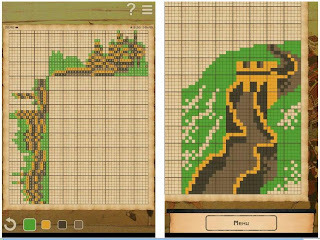
Puzzle 5.26 Chinese Wall
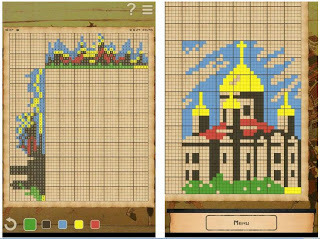
Puzzle 6.24 Cathedral
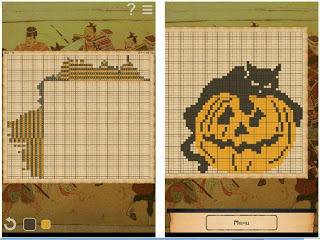
Puzzle 7.4 Halloween
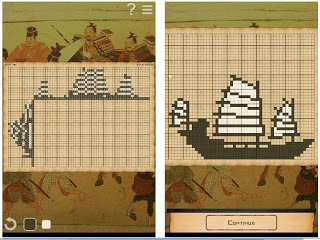
Puzzle 7.8 Junk
Three of the CrossMe Color puzzles (3.13, 3.27, and 7.3) were so difficult that I couldn't find a starting point on the primary color. After hours -- and hours -- of frustrating attempts, I sought out the CrossMe Color Solutions Blog. Trust me, I didn't really want to snag a few starting lines from these puzzle solutions, and yet I didn't want to leave these three puzzles incomplete any longer. There were much harder puzzles that I have completed on my own, so why these three gave me such difficulty, I cannot say.
Three more puzzle game time-wasters are Puzzle Retreat, Splice (286MB), and Trainyard. In the former you must move your pieces to fill in the open holes by sliding across blocks of ice, for example. And in the latter, your goal is to move each train to its own station. Sounds easy enough, right? Then why are there solution apps and websites?.... Splice, the game pictured in the middle above, is a different sort of puzzle game: you are a geneticist and must rearrange cells into a target structure.

Two of the adventures games in my app drawer are pictured above: Broken Sword: Director's Cut and The Curse. I enjoy a good adventure game, but the problem comes down to storage: adventure games are typically huge in size: Broken Sword, for example, is 539MB (compared to, say, CrossMe Color, which is less than 7MB). And remember, my N7 contains only 16GB of total storage, and no card slot. Were I to purchase a second gen N7, I would definitely buy the 32GB model. One adventure game that looks quite intriguing, Yesterday, is priced at $4.99 and clocks in at 981MB -- nearly one gig in size. I'll give it a try at the point when I'm ready to uninstall a few of my other games to make room for it.

Puzzlers, adventure games, and now physics games -- these two in particular: World of Goo and Puddle THD (167MB). What's especially cool about Puddle THD is the fact that it is specifically designed for Tegra 3 powered devices, like the N7. Most games on Android devices require you to move your finger on the screen in order to move an object; not so with Puddle THD. Grab hold of both sides of the tablet and move the entire tablet as needed to move the puddle of colored liquid along wires, through tubes, etc. as you work your way past obstacles like fire and electricity. If you click on the app link above you can watch a one and a half minute YouTube teaser video (which also links to a complete walk through of the game).

This next category of games combines the best of everything so far: adventure, puzzles, and physics; these games tend to cost a bit more than a typical paid game and are also larger in size. Three that I would recommend that are in my app drawer: Eufloria HD (172MB), Freeze! (41MB), and Waking Mars (257MB). Many of the apps shown here have teaser videos available on their app pages in the Google Play Store. The tag line for Eufloria reads: "Experience space exploration, conquest, plant growth and bio mechanical evolution." For Freeze!: "It was a wonderful day for our anonymous hero, at least until the moment when he was torn from his loved ones by a viciously sharp grappling hook." And, lastly, the tag line for Waking Mars: "In 2097, life is discovered on Mars." All of these games have won multiple game awards across devices.
And then there are the games that are a wee bit different than your standard adventure, physics, or puzzle game:
 Draw a Stickman: EPIC is an adventure game, but with a twist: You draw the stickman, and then guide him through the adventure, drawing a variety of tools and weapons to overcome the puzzles and obstacles in your path.
Draw a Stickman: EPIC is an adventure game, but with a twist: You draw the stickman, and then guide him through the adventure, drawing a variety of tools and weapons to overcome the puzzles and obstacles in your path. In Osmos HD, you are in a galactic mote, absorbing smaller organisms to increase your size and energy, while avoiding destruction from larger organisms -- while a hypnotic, electronic soundtrack plays in the background.
In Osmos HD, you are in a galactic mote, absorbing smaller organisms to increase your size and energy, while avoiding destruction from larger organisms -- while a hypnotic, electronic soundtrack plays in the background. Plague Inc. -- a hardcore strategy game -- differs from most games in that, instead of trying to save humanity, your task is to spread the plague while defeating everything humanity throws at you to kill you.
Plague Inc. -- a hardcore strategy game -- differs from most games in that, instead of trying to save humanity, your task is to spread the plague while defeating everything humanity throws at you to kill you. And, lastly, in Virtual City (78MB) you build and manage your own city. Options include a Kennedy Space Center-like environment, amusement park, and more: 50 levels in 5 settings: California, Colorado, Michigan, Montana, and New York.
And, lastly, in Virtual City (78MB) you build and manage your own city. Options include a Kennedy Space Center-like environment, amusement park, and more: 50 levels in 5 settings: California, Colorado, Michigan, Montana, and New York.You won't find any arcade style or shooter games in my app drawer; they're just not my type of game. But, if that's your gaming preference, you will be amazed by the myriad of such games that are available.
I would suggest installing gReader or the paid version, gReader Pro, or even the Feedly app and then subscribing to websites like Android Central, Android Police, and Droid Life, to name only three -- and then read their feeds daily, clicking only on the links that interest you. I believe it is Droid Life that posts a review of the Top 25 new apps each month; if you read nothing else, read this.
A Day in the Life with Android: Part 7: New AppsForthcoming

Published on March 20, 2013 15:53
March 17, 2013
Selected Links & Things
Here are some links that you may find of interest from the past few weeks. My apologies that these haven't been posted in a more timely fashion, but other priorities blah, blah, blah.
Courtesy of Quote-Unquote Apps (@qapps), we have a new version of the Courier Prime font, IBM's classic public domain typeface, which has been redesigned to look good in print and on-screen. So if you still use Courier Prime (I'm a Times Roman kinda guy, myself) for your manuscripts, you'll want to check this out. Easy-to-install for both PCs and Macs; instructions included. (via BoingBoing.net)
Mary Doria Russell is the author of the well-known 1996 alien contact/Jesuits in space novel The Sparrow and its sequel
Children of God
and its sequel
Children of God
 , and most recently
Doc
, and most recently
Doc
 , a novel of "Doc" Holliday and Wyatt Earp. On the Washington Post Book Blog, Mary shares her story with columnist Ron Charles (@RonCharles) on the "perils (and rewards) of being a midlist novelist": "Just as her new novel, Doc, was being released in 2011, she got word that her publisher [Random House] was not interested in any more books from her."
, a novel of "Doc" Holliday and Wyatt Earp. On the Washington Post Book Blog, Mary shares her story with columnist Ron Charles (@RonCharles) on the "perils (and rewards) of being a midlist novelist": "Just as her new novel, Doc, was being released in 2011, she got word that her publisher [Random House] was not interested in any more books from her."
What if you could buy your way onto the New York Times bestseller list? Think it's impossible? Not if you have enough money, as detailed by one author's experience in Forbes.com's "Here's How You Buy Your Way Onto The New York Times Bestsellers List." ResultSource, a San Diego-based marketing consultancy, specializes in getting books onto bestseller lists, assuming you have $200,000-plus to invest. The author in question couldn't afford the NYT, so he settled for the Wall Street Journal's list.
"How I made $2,000 in 7 days launching my ebook." Programmer Josh Earl, author of Sublime Productivity: Code Like a Pro with Today's Premier Text Editor ebook, writes: "The book is growing steadily, and with it, a sense of panic: What happens when I’m done? My entire promotional strategy consists of pushing the publish button! I’m a programmer, not a sales wizard. Marketing seems like black magic. The thought of my hard work going to waste makes me sick." (via Hacker News)
Digital Book World (@digibookworld) has an excerpt from a new book on publishing by former Apple guru Guy Kawasaki; the book is entitled APE: Author, Publisher, Entrepreneur-How to Publish a Book . The section "Appearance Is Everything" covers such topics as: Front Matter; Ebook Front Matter; Organization Name; Blurb Overload; Gaffes; and Crappy Interior Design. Authors, even those not self-publishing, would be wise to read this excerpt, if not the entire book, which includes manuscript and text formatting in the "Gaffes" section.
. The section "Appearance Is Everything" covers such topics as: Front Matter; Ebook Front Matter; Organization Name; Blurb Overload; Gaffes; and Crappy Interior Design. Authors, even those not self-publishing, would be wise to read this excerpt, if not the entire book, which includes manuscript and text formatting in the "Gaffes" section.
The Original Hacker's Dictionary: "Many years after the original book went out of print, Eric Raymond picked it up, updated it and republished it as the New Hacker's Dictionary. Unfortunately, in the process, he essentially destroyed what held it together, in various ways: first, by changing its emphasis from Lisp-based to UNIX-based (blithely ignoring the distinctly anti-UNIX aspects of the LISP culture celebrated in the original); second, by watering down what was otherwise the fairly undiluted record of a single cultural group through this kind of mixing; and third, by adding in all sorts of terms which are 'jargon' only in the sense that they're technical. This page, however, is pretty much the original, snarfed from MIT-AI around 1988." (via Hacker News)
"Aaron Hillel Swartz (November 8, 1986 – January 11, 2013) was an American computer programmer, writer, political organizer and Internet activist." At least that's what Wikipedia opens with, when you search for "Aaron Swartz." But Aaron was so much more: as a teenager he helped develop the RSS feed, which has been in the tech news lately as Google prepares to shut down its Google Reader service. Aaron also helped develop the Creative Commons licensing, which many have used to publish their work openly on the internet. Facing years of incarceration from an overzealous prosecutor, Aaron committed suicide on January 11. I'll leave you to decide the rights and wrongs of the case (a quick Google search will yield plenty of results). Aaron Swartz's weblog, Raw Thought, has been preserved for free download as PDF, mobi, and epub files. (via Hacker News) Here's an excerpt:
From The National Security Archive: "The Zero Dark Thirty File -- Lifting the Government's Shroud Over the Mission That Killed Osama bin Laden." Twenty-two files including photos, letters, and details on the mission that brought down bin Laden.
And lastly, in 1942 LIFE magazine sent Margaret Bourke-White, America’s first accredited woman photographer during WWII, to spend time with the now legendary VIII Bomber Command in England. During her assignment, she managed to snap a series of color photographs, many of which never actually made it to her feature article. Over 70 years later, LIFE has finally released these unpublished color photos.

Courtesy of Quote-Unquote Apps (@qapps), we have a new version of the Courier Prime font, IBM's classic public domain typeface, which has been redesigned to look good in print and on-screen. So if you still use Courier Prime (I'm a Times Roman kinda guy, myself) for your manuscripts, you'll want to check this out. Easy-to-install for both PCs and Macs; instructions included. (via BoingBoing.net)
Mary Doria Russell is the author of the well-known 1996 alien contact/Jesuits in space novel The Sparrow
 and its sequel
Children of God
and its sequel
Children of God
 , and most recently
Doc
, and most recently
Doc
 , a novel of "Doc" Holliday and Wyatt Earp. On the Washington Post Book Blog, Mary shares her story with columnist Ron Charles (@RonCharles) on the "perils (and rewards) of being a midlist novelist": "Just as her new novel, Doc, was being released in 2011, she got word that her publisher [Random House] was not interested in any more books from her."
, a novel of "Doc" Holliday and Wyatt Earp. On the Washington Post Book Blog, Mary shares her story with columnist Ron Charles (@RonCharles) on the "perils (and rewards) of being a midlist novelist": "Just as her new novel, Doc, was being released in 2011, she got word that her publisher [Random House] was not interested in any more books from her."What if you could buy your way onto the New York Times bestseller list? Think it's impossible? Not if you have enough money, as detailed by one author's experience in Forbes.com's "Here's How You Buy Your Way Onto The New York Times Bestsellers List." ResultSource, a San Diego-based marketing consultancy, specializes in getting books onto bestseller lists, assuming you have $200,000-plus to invest. The author in question couldn't afford the NYT, so he settled for the Wall Street Journal's list.
"How I made $2,000 in 7 days launching my ebook." Programmer Josh Earl, author of Sublime Productivity: Code Like a Pro with Today's Premier Text Editor ebook, writes: "The book is growing steadily, and with it, a sense of panic: What happens when I’m done? My entire promotional strategy consists of pushing the publish button! I’m a programmer, not a sales wizard. Marketing seems like black magic. The thought of my hard work going to waste makes me sick." (via Hacker News)
Digital Book World (@digibookworld) has an excerpt from a new book on publishing by former Apple guru Guy Kawasaki; the book is entitled APE: Author, Publisher, Entrepreneur-How to Publish a Book
 . The section "Appearance Is Everything" covers such topics as: Front Matter; Ebook Front Matter; Organization Name; Blurb Overload; Gaffes; and Crappy Interior Design. Authors, even those not self-publishing, would be wise to read this excerpt, if not the entire book, which includes manuscript and text formatting in the "Gaffes" section.
. The section "Appearance Is Everything" covers such topics as: Front Matter; Ebook Front Matter; Organization Name; Blurb Overload; Gaffes; and Crappy Interior Design. Authors, even those not self-publishing, would be wise to read this excerpt, if not the entire book, which includes manuscript and text formatting in the "Gaffes" section. The Original Hacker's Dictionary: "Many years after the original book went out of print, Eric Raymond picked it up, updated it and republished it as the New Hacker's Dictionary. Unfortunately, in the process, he essentially destroyed what held it together, in various ways: first, by changing its emphasis from Lisp-based to UNIX-based (blithely ignoring the distinctly anti-UNIX aspects of the LISP culture celebrated in the original); second, by watering down what was otherwise the fairly undiluted record of a single cultural group through this kind of mixing; and third, by adding in all sorts of terms which are 'jargon' only in the sense that they're technical. This page, however, is pretty much the original, snarfed from MIT-AI around 1988." (via Hacker News)
"Aaron Hillel Swartz (November 8, 1986 – January 11, 2013) was an American computer programmer, writer, political organizer and Internet activist." At least that's what Wikipedia opens with, when you search for "Aaron Swartz." But Aaron was so much more: as a teenager he helped develop the RSS feed, which has been in the tech news lately as Google prepares to shut down its Google Reader service. Aaron also helped develop the Creative Commons licensing, which many have used to publish their work openly on the internet. Facing years of incarceration from an overzealous prosecutor, Aaron committed suicide on January 11. I'll leave you to decide the rights and wrongs of the case (a quick Google search will yield plenty of results). Aaron Swartz's weblog, Raw Thought, has been preserved for free download as PDF, mobi, and epub files. (via Hacker News) Here's an excerpt:
I’m not such a nuisance to the world, and the kick I get out of living can, I suppose, justify the impositions I make on it. But when life isn’t so fun, well, then I start to wonder. What’s the point of going on if it’s just trouble for us both? My friends will miss me, I am told. . . . But even so, I feel reticent. Even among my closest friends, I still feel like something of an imposition, and the slightest shock, the slightest hint that I’m correct, sends me scurrying back into my hole. (2007)
From The National Security Archive: "The Zero Dark Thirty File -- Lifting the Government's Shroud Over the Mission That Killed Osama bin Laden." Twenty-two files including photos, letters, and details on the mission that brought down bin Laden.
And lastly, in 1942 LIFE magazine sent Margaret Bourke-White, America’s first accredited woman photographer during WWII, to spend time with the now legendary VIII Bomber Command in England. During her assignment, she managed to snap a series of color photographs, many of which never actually made it to her feature article. Over 70 years later, LIFE has finally released these unpublished color photos.

Published on March 17, 2013 14:59
February 28, 2013
A Day in the Life with Android (Part 5)
 This is Part 5 (albeit published much later than I had originally anticipated) in my continuing series in which I share how I use my Google/ASUS Nexus 7 tablet on a day-to-day basis. Part 1 covers my hardware accessories and business apps; Part 2 focuses on a variety of utilities; Part 3 deals with social media and related apps as well as ebook readers; and in Part 4 I review most of what is left -- a combination of utilities, news apps, and apps that didn't fit in the previous three posts, excluding audio-video and related apps, which I have reserved for this post.
This is Part 5 (albeit published much later than I had originally anticipated) in my continuing series in which I share how I use my Google/ASUS Nexus 7 tablet on a day-to-day basis. Part 1 covers my hardware accessories and business apps; Part 2 focuses on a variety of utilities; Part 3 deals with social media and related apps as well as ebook readers; and in Part 4 I review most of what is left -- a combination of utilities, news apps, and apps that didn't fit in the previous three posts, excluding audio-video and related apps, which I have reserved for this post.As I mentioned in the previous entry in this series: "...what would an Android device be without at least a few games, some tunes, and a movie or two."
In Part 2 I talked about "cloud storage" services -- necessary because the Nexus 7's storage capacity is limited and the device has no card slot. [Note: If you read Part 2 previously, please read the update I posted on 02/26/2013 regarding a strong warning about Bitcasa cloud storage; and in place of Bitcasa, I have recommended Box cloud storage.]
But what do you do when you have no wireless access to those cloud storage services, and yet you need access to your documents and spreadsheets, as well as books, music, and movies, say, for that long plane ride, or the hotel stay where there is no free wireless?
 You use the Nexus Media Importer app and a micro USB On-the-Go (OTG) cable. The Nexus Media Importer uses the N7's micro USB port, the same port used for charging the device. Just as the app says, this is for importing (and streaming) to the N7 only. You cannot move/save files from the N7 to the USB device.
You use the Nexus Media Importer app and a micro USB On-the-Go (OTG) cable. The Nexus Media Importer uses the N7's micro USB port, the same port used for charging the device. Just as the app says, this is for importing (and streaming) to the N7 only. You cannot move/save files from the N7 to the USB device.
The cable needed must be described as a "Micro USB OTG to USB 2.0 Adapter." The one I use (pictured here) is the T & S Electronics Micro USB OTG Cable
 , which cost $10.00 on Amazon. An online search, even on Amazon, will find cheaper cables, but I went with this one because of its design, the lifetime warranty, and because the company is located in the US (Los Angeles).
, which cost $10.00 on Amazon. An online search, even on Amazon, will find cheaper cables, but I went with this one because of its design, the lifetime warranty, and because the company is located in the US (Los Angeles). As with the Google Chrome browser, or all Google apps for that matter, Google Calendar syncs across all devices. If I set up a calendar appointment on my PC, it shows up on the N7, and vice versa. When I schedule an appointment, I always set up reminders to be sent to me via email and the Android notification bar.
As with the Google Chrome browser, or all Google apps for that matter, Google Calendar syncs across all devices. If I set up a calendar appointment on my PC, it shows up on the N7, and vice versa. When I schedule an appointment, I always set up reminders to be sent to me via email and the Android notification bar. If you keep up on tech news then you may have heard about the iPhone fiasco when Apple decided to do away with Google Maps and go with their own map app. (The fiasco cost a couple execs their jobs at Apple!) I recall reading an alert put out by the Australian travel bureau, I believe it was, warning tourists that an iPhone map error could be detrimental to travelers. With Google Maps, I can map out my destination, including driving directions, and then do a screenshot1 of each so that I have access to the information on the N7 when there is no wifi available, like in the car.
If you keep up on tech news then you may have heard about the iPhone fiasco when Apple decided to do away with Google Maps and go with their own map app. (The fiasco cost a couple execs their jobs at Apple!) I recall reading an alert put out by the Australian travel bureau, I believe it was, warning tourists that an iPhone map error could be detrimental to travelers. With Google Maps, I can map out my destination, including driving directions, and then do a screenshot1 of each so that I have access to the information on the N7 when there is no wifi available, like in the car. ESPN's ScoreCenter for Android is ideal for tracking favorite sports and teams. I'm not much for sports, but I do follow a few college football teams, and local NFL and MLB teams. With ScoreCenter, you can track a multitude of sports, from Autoracing to MMA, and even Cricket! The app's "holo" design has recently been updated for the Nexus 7 and looks great. You can set up to receive notifications after each inning or quarter, for example, and receive news notifications for breaking sports stories.
ESPN's ScoreCenter for Android is ideal for tracking favorite sports and teams. I'm not much for sports, but I do follow a few college football teams, and local NFL and MLB teams. With ScoreCenter, you can track a multitude of sports, from Autoracing to MMA, and even Cricket! The app's "holo" design has recently been updated for the Nexus 7 and looks great. You can set up to receive notifications after each inning or quarter, for example, and receive news notifications for breaking sports stories.Music
I have the Google Play Music Manager installed on my PC. Google provides free cloud storage for thousands of my songs. All I have to do is point the Music Manager to the folder on my PC that contains my iTunes songs and podcasts, my Amazon MP3s, etc., and whenever a new file is added to that folder, the Music Manager will automatically upload it to my Google Play Music Library. How cool is that!
The Google Play music store also offers a "Free Song of the Day" -- though it's actually more like every three days.
 The Google Play Music app allows me to play an individual song, shuffle my library, and access my playlists on the N7. An equalizer can be activated for each song as well (click on the 3 dots in the top right corner of the screen). There are better equalizer apps available, but from what I have read in the reviews, they all seem to not work properly under the Android Jelly Bean OS. So stick with the built-in equalizer until developers figure out the issue with JB.
The Google Play Music app allows me to play an individual song, shuffle my library, and access my playlists on the N7. An equalizer can be activated for each song as well (click on the 3 dots in the top right corner of the screen). There are better equalizer apps available, but from what I have read in the reviews, they all seem to not work properly under the Android Jelly Bean OS. So stick with the built-in equalizer until developers figure out the issue with JB.I've seen a few complaints about the speakers in the N7, but I think they are fairly impressive given the size and slimness of the device. But, since music is all about the speakers, I added a Monster ClarityHD Bluetooth Wireless Speaker
 to my Nexus 7 hardware:
to my Nexus 7 hardware:
And if, for some reason, you can't get the Bluetooth to work properly, just plug in a dual 3.5mm stereo cable into the N7's earphone jack and the speaker's audio-in jack, and you'll be good to go.
One more point to keep in mind: this music app -- and the music/radio apps that follow -- will all play music in the background while you work on documents, read and respond to your email, and most other activities on the N7.
 The first app pictured here is TuneIn Radio Pro: for online radio streaming, be it music, sports, news, or whatever is streaming from the multitude of radio stations available via this app. Just the other day I was listening to a local indie station, S*ALT (aka Save Alternative) that was playing a lengthy set of songs by a band called Pinback. This app also allows you to record the music being played, and you can even schedule the recording in advance. The second app, XiaaLive Pro, differs in that you can search and stream specific songs; I haven't used this app as much as TuneIn.
The first app pictured here is TuneIn Radio Pro: for online radio streaming, be it music, sports, news, or whatever is streaming from the multitude of radio stations available via this app. Just the other day I was listening to a local indie station, S*ALT (aka Save Alternative) that was playing a lengthy set of songs by a band called Pinback. This app also allows you to record the music being played, and you can even schedule the recording in advance. The second app, XiaaLive Pro, differs in that you can search and stream specific songs; I haven't used this app as much as TuneIn.Movies
The Google Play Movies app, just like Google Play Books, comes with the N7, but only works for movies obtained through the Google Play store. When I want to watch Tori Amos perform on The Artists Den (mp4) or Nirvana's landmark "Nevermind" video (flv) or those restored Fleischer Studios' original Superman cartoons (mp4), I turn to this app:
 MX Player is a multi-purpose video player. It has played every video format that I have thrown at it, at least so far. There is a "Pro" version that costs $5.70 and is add-free, but so far I've been satisfied with the free app.
MX Player is a multi-purpose video player. It has played every video format that I have thrown at it, at least so far. There is a "Pro" version that costs $5.70 and is add-free, but so far I've been satisfied with the free app. Most DVD purchases now come with a digital copy of the movie; typically, these digital copies can be downloaded onto one computer and one mobile device. Flixster is one of these online digital movie services, which allows me to access my Flixster online digital movies on the N7.
Most DVD purchases now come with a digital copy of the movie; typically, these digital copies can be downloaded onto one computer and one mobile device. Flixster is one of these online digital movie services, which allows me to access my Flixster online digital movies on the N7.A Day in the Life with Android: Part 6: GamesForthcoming
--------------------Footnote
1. A screenshot can be made of absolutely any screen on the Nexus 7. To snap a screenshot simply hold down the the power button and the volume down button at the same time. That's it. The screenshot will be saved in the N7's Gallery. And, if you have Dropbox installed as well (and wifi turned on), the screenshot will automatically be uploaded to Dropbox and saved in a folder entitled "Camera Uploads."

Published on February 28, 2013 15:26
February 26, 2013
The Soul of a Novella: Brandon Sanderson's The Emperor's Soul
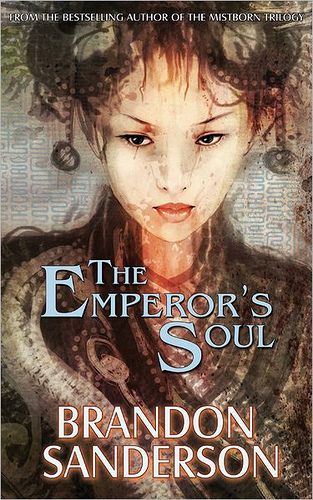
The novella is a rather intriguing literary work: it is too long to be considered a "short story," and yet it is too short to be categorized as a novel. Many authors thrive at novella-length stories, but, alas, there are few markets for work of this length.
I've been quite fortunate to have worked on some extraordinary novellas, including: Turquoise Days by Alastair Reynolds, the first entry in Golden Gryphon Press's limited edition chapbook series, and later published by Ace Books as a hardcover double entitled Diamond Dogs, Turquoise Days
 ; Lucius Shepard's Louisiana Breakdown (out of print) won the 2004 International Horror Guild Award for best long fiction, and was a finalist for the Bram Stoker Award that same year; "The Concrete Jungle," included in Charles Stross's
The Atrocity Archives
; Lucius Shepard's Louisiana Breakdown (out of print) won the 2004 International Horror Guild Award for best long fiction, and was a finalist for the Bram Stoker Award that same year; "The Concrete Jungle," included in Charles Stross's
The Atrocity Archives
 , won the 2005 Hugo Award for best novella; and
After the Fall, Before the Fall, During the Fall
, won the 2005 Hugo Award for best novella; and
After the Fall, Before the Fall, During the Fall
 by Nancy Kress, currently a finalist for the Nebula Award.
by Nancy Kress, currently a finalist for the Nebula Award.Which brings me to the subject of this blog post: novella The Emperor's Soul
 by Brandon Sanderson, published by Tachyon Publications (as is the previously mentioned Nancy Kress novella).
by Brandon Sanderson, published by Tachyon Publications (as is the previously mentioned Nancy Kress novella).When I read this year's Nebula Awards nominees, I was surprised -- and disappointed -- that The Emperor's Soul wasn't on the list. When I worked on this book last year, copy editing the manuscript and then proof reading the final layout -- I was awestruck by the story's premise (courtesy of TOR.com):
When Shai is caught replacing the [Emperor's] Moon Scepter with her nearly flawless forgery, she must bargain for her life. An assassin has left the Emperor Ashravan without consciousness, a circumstance concealed only by the death of his wife. If the emperor does not emerge after his hundred-day mourning period, the rule of the Heritage Faction will be forfeit and the empire will fall into chaos.
Shai is given an impossible task: to create--to Forge--a new soul for the emperor in less than one hundred days while trapped behind a door sealed in her own blood.
The Emperor's Soul is set in the same world as Sanderson's earlier novel Elantris, but the novella stands completely on its own. And the writing itself is brilliant.
Brandon Sanderson was the Author Guest of Honor at BayCon 2012, held annually here in Santa Clara, California. I participated on a panel with Brandon, entitled "The Top Ten Rookie Author Gaffes," at 10:00AM on Monday morning. I was impressed with Brandon's style and natural camaraderie with the audience. He possesses a great deal of knowledge and writing skill, and is quick to share this with the attendees. He is definitely "paying it forward," even meeting with attendees after the panel has ended in order to continue the discussion.
I realize it is too late for the Nebula Awards, but the Hugo Awards nominations are still open (at least for another 12 days), and voting for the World Fantasy Awards remains open until May 31, 2013. I ask that you consider Brandon Sanderson's The Emperor's Soul, in the novella category.
Tachyon Publications has reactions to the novella from Library Journal, TOR.com, and Fantasy Book Review, among others; and TOR.com has a review by Stefan Raets and an excerpt from the book itself: I will post the Prologue here, with a link at the bottom to the full excerpt on Tor.com.
But one more thing: If you have already purchased the book -- or plan to purchase the book -- the author will send you a free copy of the ebook. All you need to do is send him a scan or photograph of the receipt, or even a photograph of you holding the book to receive your free ebook. Details can be found on Brandon Sanderson's website.
Prologue
Gaotona ran his fingers across the thick canvas, inspecting one of the greatest works of art he had ever seen. Unfortunately, it was a lie.
"The woman is a danger." Hissed voices came from behind him. "What she does is an abomination."
Gaotona tipped the canvas toward the hearth's orange-red light, squinting. In his old age, his eyes weren't what they had once been. Such precision, he thought, inspecting the brush strokes, feeling the layers of thick oils. Exactly like those in the original.
He would never have spotted the mistakes on his own. A blossom slightly out of position. A moon that was just a sliver too low in the sky. It had taken their experts days of detailed inspection to find the errors.
"She is one of the best Forgers alive." The voices belonged to Gaotona's fellow arbiters, the empire's most important bureaucrats. "She has a reputation as wide as the empire. We need to execute her as an example."
"No." Frava, leader of the arbiters, had a sharp, nasal voice. "She is a valuable tool. This woman can save us. We must use her."
Why? Gaotona thought again. Why would someone capable of this artistry, this majesty, turn to forgery? Why not create original paintings? Why not be a true artist?
I must understand.
"Yes," Frava continued, "the woman is a thief, and she practices a horrid art. But I can control her, and with her talents we can fix this mess we have found ourselves in."
The others murmured worried objections. The woman they spoke of, Wan ShaiLu, was more than a simple con artist. So much more. She could change the nature of reality itself. That raised another question. Why would she bother learning to paint? Wasn't ordinary art mundane compared to her mystical talents?
So many questions. Gaotona looked up from his seat beside the hearth. The others stood in a conspiratorial clump around Frava's desk, their long, colorful robes shimmering in the firelight. "I agree with Frava," Gaotona said.
The others glanced at him. Their scowls indicated they cared little for what he said, but their postures told a different tale. Their respect for him was buried deep, but it was remembered.
"Send for the Forger," Gaotona said, rising. "I would hear what she has to say. I suspect she will be more difficult to control than Frava claims, but we have no choice. We either use this woman's skill, or we give up control of the empire."
The murmurs ceased. How many years had it been since Frava and Gaotona had agreed on anything at all, let alone on something so divisive as making use of the Forger?
One by one, the other three arbiters nodded.
"Let it be done," Frava said softly.
Excerpt continued on TOR.com;scroll down about one-quarter of the page to "Day Two."
The Emperor's Soul copyright © 2012 Dragonsteel Entertainment, LLC

Published on February 26, 2013 16:11
February 19, 2013
This is not a still from Blade Runner....
"A new life awaits you in the off-world colonies! A chance to begin again in a golden land of opportunity and adventure!"

On January 19 (now you see how far behind I am on blog posts!) I was reading through my blog and forum feeds when I came upon this photograph on the Philip K. Dick blog Total Dick-Head. Little was said about the photo, other than "that's not a still from Blade Runner" and it's "the smog in Beijing, and some crazy building." I shared this photo on Google+, Facebook, and Twitter, with what little information I had.
Aside from a couple "likes" and such on G+ and FB, nothing came of my posts on those two sites. But, Twitter was something else altogether....
I used the #PKD hashtag on my tweet, and that really got people's attention. Retweets and comments were coming in as fast as I could read them, over the course of days. Some of the retweets were in German, Spanish, and Russian, as well as character sets I didn't recognize.
I received a tweet from @spenap (Simón P.) informing me that the original source of the photo was the Wall Street Journal (@WSJ) blog. Simón also noted that the photo had been posted to Tumbler, and then picked up by Gizmodo. As he was kind enough to include a link to the WSJ blog in his tweet, I immediately checked it out.
This photo was among the "Photos of the Day" for January 14 on the WSJ blog, and is credited to ChinaFotoPress/Zuma Press. The caption under the photograph reads:
AIR OF MYSTERY: Haze obscured the Pangu Plaza Office Building in Beijing Saturday. Beijing on Sunday issued its first-ever 'orange' fog warning, an alert to the elderly, children and people suffering from respiratory disease to stay indoors and limit exposure to the pollution.
I later received a tweet from @nntd, stating "I took this pic." I replied, hoping to get clarification and/or confirmation, but received no response. But I will assume she/he is the photographer. The name associated with @nntd is in a foreign character set and thus only shows up in my twitter feed as three square symbols.
A brief search led me to the Gizmodo blog post. There are more than 40 comments, including one from "Settings" that includes a photo of this same building, from a different perspective, taken on a clear day:

According to this and other comments, these buildings are referred to as the dragon building, which, from the air, evidently looks like a dragon.
But back to my twitter feed: Just a few of the tweets I received in response:
Kyle Baker (@kbaker): That's the Beijing I remember while there. Eery resemblance. Beijing can be quite nice on clear days, though.
@mangochutney: it [the smog] only gets this bad when they power up the coal-fired power plants outside the 3rd ring of the city.
@mangochutney: the amount of soot that accumulated over the course of 2d on my closed balcony was scary.
Richard Lai (@richardlai): I'm in Beijing right now and I can confirm that the air is still very bad. Brought a couple of N95 masks along.
This whole twitter experience was really quite fascinating. To date my tweet has been retweeted 2,470 times, and that's not counting all the dozens of personal responses I received. I remain amazed....
I'll close with one last photo -- a cityscape -- and this is a still from Blade Runner, courtesy of Dan North's Spectacular Attractions blog:

"I've seen things you people wouldn't believe. Attack ships on fire off the shoulder of Orion. I watched C-beams glitter in the dark near the Tannhauser gate. All those moments will be lost in time... like tears in rain... Time to die."
~Roy Batty, Blade Runner

Published on February 19, 2013 17:13

